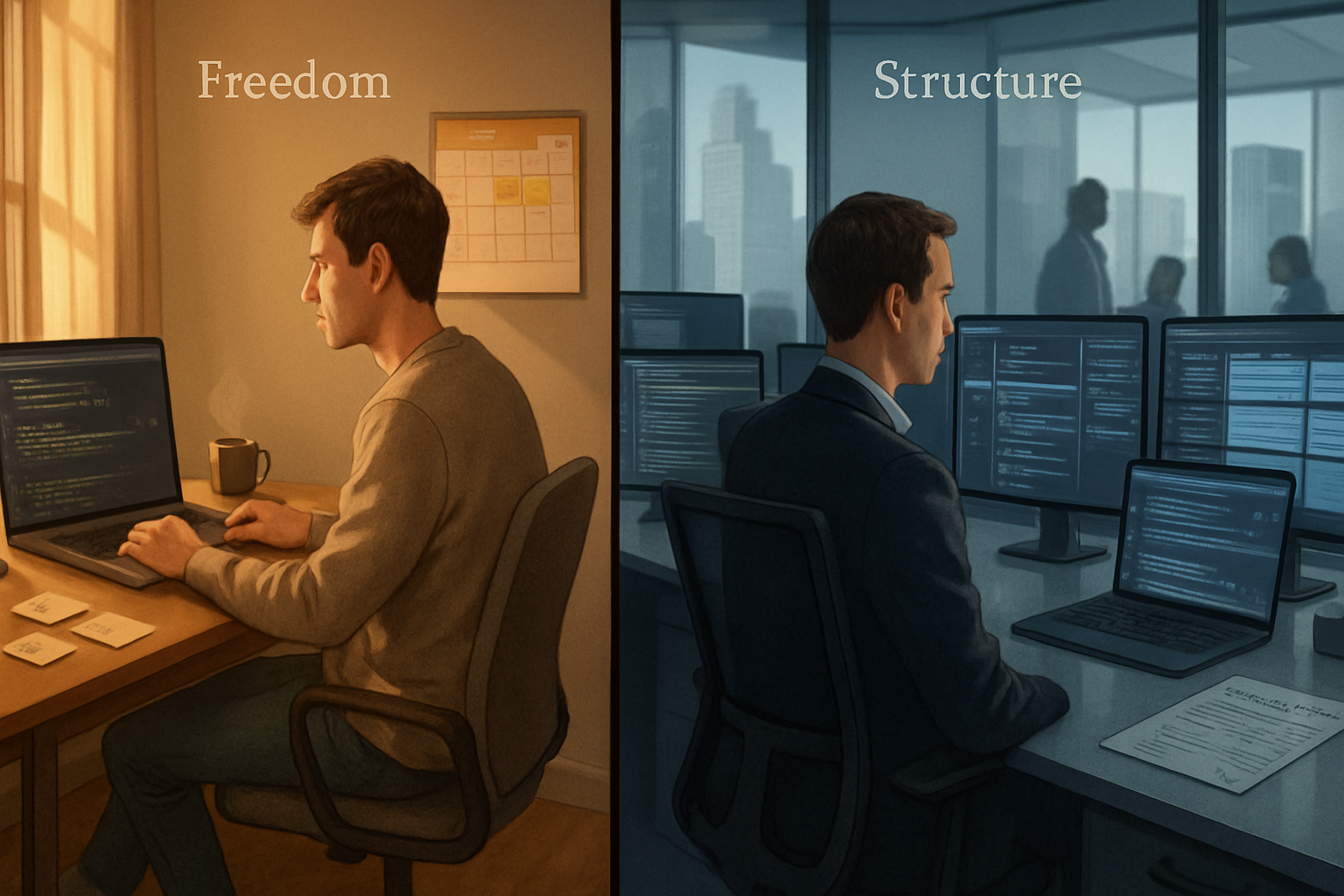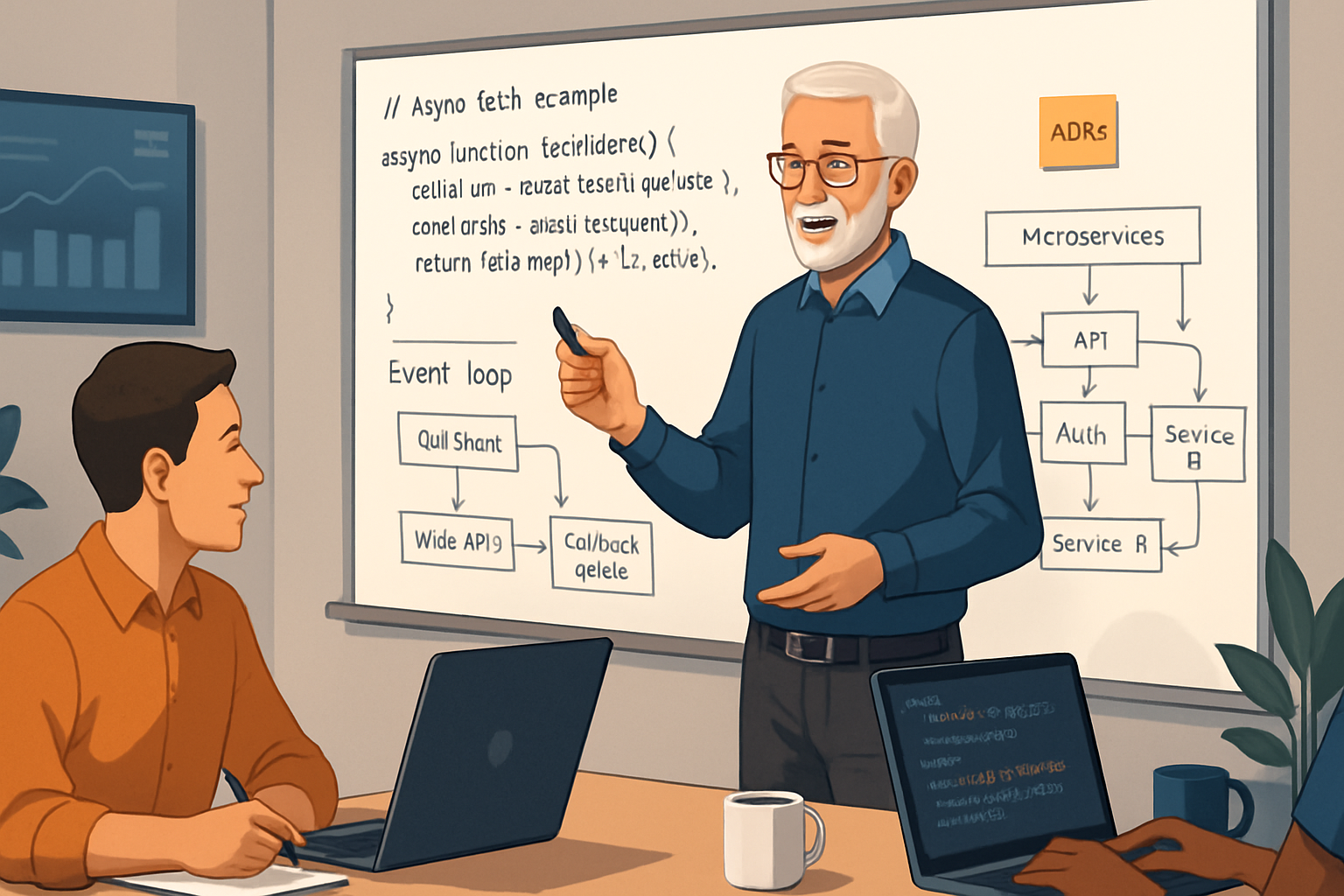· career · 8 min read
The Freelance Freedom vs. Corporate Structure: Which Path is Right for You?
A practical, in-depth comparison of being a freelance JavaScript developer versus taking a full-time role at a big tech company - covering money, emotions, career growth, daily routines, and an action plan to choose and transition confidently.

What you’ll get from this article
You’ll leave with a clear framework to decide between freelancing and a full-time job at a big tech company. You’ll know how to compare total compensation, emotional fit, skill growth, stability, and long-term career trajectories. And you’ll walk away with an actionable 90‑day plan whether you want to stay, switch, or build a hybrid.
Read on if you want to choose deliberately - not by default.
Quick outcome-first summary
Both paths can make you a successful, well-paid JavaScript developer. One buys flexibility and variety. The other buys stability, scale, and structured growth. Which matters most depends on your money needs, risk tolerance, learning style, and life stage. Decide based on what you want your day-to-day to feel like - not on prestige or fear.
A short snapshot: how they differ in plain language
- Freelance JavaScript developer: You own your schedule, clients, roadmap, and taxes. You juggle sales, delivery, and admin. Income can swing. Your learning is self-directed.
- Full-time at big tech: You get a predictable paycheck, formal benefits, and career ladders. You trade some autonomy for stability and scaled impact. Your work is often narrower but reaches more users.
Now let’s unpack these differences in depth.
Financial comparison: more than just salary
Money isn’t only pay. It’s pay + benefits + taxes + volatility.
1) Base pay and variability
- Big tech: Salaries are generally higher than market median for software developers. Total compensation commonly mixes base salary, bonus, and equity. Stack Overflow and Glassdoor data show sizable compensation packages at large firms and public salary disclosures can help benchmark.
- Freelance: Hourly or per-project rates vary widely. Experienced JS freelancers can earn more than their corporate counterparts in high-demand niches, but income is uneven and depends on pipeline, specialization, and negotiation.
Tip: Treat freelance rates as gross revenue, not take-home. You’ll lose a portion to taxes, benefits, software, marketing, and unpaid time.
2) Benefits and their monetary value
Big tech typically provides:
- Health, dental, vision insurance
- Retirement contributions (401k match)
- Paid leave, parental benefits
- Stock or RSU grants
- Learning stipends, equipment
These reduce your personal spending and risk, and can be valued at tens of thousands annually depending on the company. For guidance on valuing offers, see Glassdoor and employer benefit comparisons.
As a freelancer you must replace those. Health insurance premiums, retirement savings, and paid time off come out of your rates.
3) Taxes and admin
As a freelancer you’ll handle self-employment taxes, quarterly estimated payments, bookkeeping, and invoicing. This can be 15–30% or more of gross income depending on deductions and country.
Corporate payroll handles income tax withholding, employer payroll taxes, and usually simplifies compliance.
4) Downside risk and runway
Freelancers need a buffer. Aim for 3–6 months of personal living expenses in accessible cash if you’re dependent on freelancing income.
Big tech employees rarely face month-to-month income risk but can be exposed to layoffs and stock volatility.
Emotional and lifestyle aspects: how work will make you feel
Money matters. But satisfaction and stress levels matter more day-to-day.
Autonomy vs structure
- Freelance: You call many shots - clients, tech stack, hours. High autonomy fuels creativity and ownership. But making all decisions alone can be draining.
- Corporate: Decisions are shared, roadmaps are set, and approvals exist. This reduces daily friction but can limit creative freedom.
Social connection and identity
- Freelance: Work can be isolating unless you invest in meetups, co‑working, or communities. You build a portfolio identity rather than an employer identity.
- Corporate: Built-in teams, mentorship, org events, and peer feedback. This helps learning and psychological safety.
Stress and accountability
- Freelance: Stress around sales, inconsistent cash flow, and client management. High responsibility but zero corporate safety net.
- Corporate: Stress around performance reviews, politics, and dependability to stakeholders. But you usually have HR and team support.
Work-life rhythm
Freelancers can craft schedules for family, travel, or peak productivity. That’s a big win for life flexibility. But clients often expect responsiveness and deadlines can create bursts of intense work.
Corporations often have regular hours (though big tech can demand long ramps pre-launch). Your time-off is protected but less flexible day-to-day.
Career growth and skill development
Growth is not purely vertical. It’s also horizontal breadth, leadership experience, and reputational capital.
Learning pace and mentorship
- Big tech: Formal mentorship, code reviews, and structured onboarding accelerate learning. Exposure to large-scale systems, observability, and product thinking is common.
- Freelance: Learning is self-directed. You gain breadth (full project lifecycle, client communication, product decisions) rapidly. Deep architectural exposure depends on clients and projects.
Resume and market signaling
- Big tech on your CV signals scale and polish to future employers. It can open doors for leadership roles or high-salary positions later.
- Freelance experience signals initiative, client trust, and product ownership. If you can show outcomes (metrics, testimonials), it’s powerful - especially for startups or consultancy roles.
Leadership and equity upside
- Big tech often provides paths into engineering management, principal IC roles, or industry visibility that can lead to higher compensation and scope.
- Freelance scaling might mean forming an agency, hiring others, or creating products. Equity plays are less common unless you cofound a startup.
Day-to-day workflow: what a week looks like
Freelance week (typical):
- Morning: emails, proposals, billing
- Midday: deep work on project A (front-end, API integration)
- Afternoon: client calls, fixes, QA
- Evening: admin, learning, marketing
Big tech week (typical):
- Morning: standup, code reviews
- Midday: feature work, pair programming
- Afternoon: meetings with PMs, design reviews, deployment
- Weekly: 1:1s, planning, on-call rotations (maybe)
Both can include on-call responsibilities and bugs. Freelancers often juggle multiple clients; corporate engineers focus on fewer codebases but at bigger scale.
How to compare offers objectively: a small decision framework
Score each pathway (freelance vs corporate) on a scale of 1–5 for these categories, multiply by importance weights, and compare totals.
Categories to score:
- Financial security (pay + benefits)
- Net income after costs and taxes
- Predictability / volatility
- Learning and mentorship
- Autonomy and schedule
- Social connection / culture fit
- Long-term career trajectory
Weight each category by personal importance (0–10). This exercise clarifies trade-offs fast.
Practical tips: negotiating, rate-setting, and safety nets
Freelance rate calculation (simple model):
- Desired annual take-home = D
- Add estimated business costs and taxes = C
- Divide by billable weeks * billable hours per week = hourly rate
Example: Want $100k take-home + $20k costs/taxes = $120k. If you can bill 40 weeks * 25 hours = 1000 hours → $120/hr.
Negotiation tips for freelancers:
- Price outcomes, not hours. Sell features that map to business value.
- Use clear contracts: scope, change orders, payment milestones, late fees.
- Ask for a 25–50% upfront deposit for new clients.
Negotiation tips for corporate offers:
- Negotiate total comp: base, sign-on, RSUs, relocation, learning budget.
- Ask for clear performance expectations and leveling documents.
Safety-net checklist before jumping to freelancing:
- 3–6 months of personal runway (or more if dependents exist)
- 2–3 recurring clients or a pipeline
- Incorporation and accounting system set up (or a contractor platform to start)
- Health insurance plan arranged
- Contracts and templates ready
Scenarios: which path fits which stage in life?
- Early career (0–3 years): Big tech. You’ll learn fast, get mentorship, and polish fundamentals.
- Mid-career (3–8 years): Hybrid. Consider freelancing for sabbaticals, contract roles, or a part-time consultancy while staying employed.
- Family-focused or risk-averse: Big tech. The benefits and predictability matter.
- Entrepreneurial or travel-first lifestyle: Freelance. If you crave autonomy and can handle variability.
- Building a product startup: Big tech can teach scale; freelancing provides runway and validation funds.
Transition plans (90-day blueprints)
If choosing freelancing from full-time:
- 0–30 days: Save runway, set legal/financial basics, gather portfolio, and start outreach.
- 30–60 days: Land first paying clients, pilot fixed-scope projects, refine rate sheet.
- 60–90 days: Reduce corporate hours (if possible), build repeatable onboarding, finalize notice period with employer.
If choosing full-time from freelancing:
- 0–30 days: Decide dealbreakers (compensation, equity, culture). Start interviewing with clear role list.
- 30–60 days: Negotiate offers with benefit valuation. Prepare reference stories translating freelance work to product impact.
- 60–90 days: Wrap projects, document handoff, and plan for first 90 days on the job.
Resources and communities to explore
- Developer surveys and salary benchmarks: Stack Overflow Insights
- Freelance trends and guides: Upwork & Freelancers Union reports
- Company salary and benefit research: Glassdoor
- Contract templates and invoicing tools: platforms like Bonsai, AND CO, or Docracy
Final decision checklist (5 quick questions)
- Do you need predictable monthly income? Yes → corporate. No → freelancing possible.
- Do you value mentorship and scale exposure? Yes → corporate.
- Do you crave schedule and project control? Yes → freelancing.
- Can you tolerate administrative overhead and sales? If not, corporate is safer.
- Is your partner/family dependent on your income and benefits? If yes, weigh corporate benefits heavily.
Answer honestly. Your perfect answer will often be a mix.
Closing: the single best way to choose
Write down what “ideal workday” looks like for you in five years. Then ask which path gets you closer, faster, and with lower regret. Both roads can lead to professional success and financial stability. Choose the one that designs the life you want - and be prepared to pivot when priorities change.
Neither path is universally superior. One offers structure and scale; the other offers freedom and ownership. Pick the one that aligns with who you want to be tomorrow - and commit to mastering it.
References
- Stack Overflow Developer Survey - https://insights.stackoverflow.com/survey
- Upwork and Freelancers Union research on freelancing trends - https://www.upwork.com
- Glassdoor company & salary information - https://www.glassdoor.com



